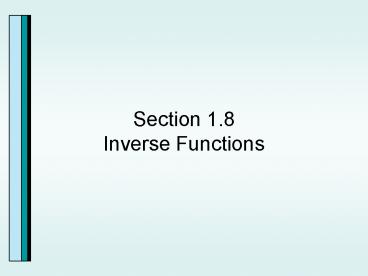Section 1.8 Inverse Functions - PowerPoint PPT Presentation
1 / 28
Title:
Section 1.8 Inverse Functions
Description:
Section 1.8 Inverse Functions * * * * * * * * * * * * * * * * * * * * * * * * Inverse Functions The function f is a set of ordered pairs, (x,y), then the changes ... – PowerPoint PPT presentation
Number of Views:349
Avg rating:3.0/5.0
Title: Section 1.8 Inverse Functions
1
Section 1.8Inverse Functions
2
- Inverse Functions
3
The function f is a set of ordered pairs, (x,y),
then the changes produced by f can be undone by
reversing components of all the ordered pairs.
The resulting relation (y,x), may or may not be a
function. Inverse functions have a special
undoing relationship.
4
(No Transcript)
5
Relations, Functions 11
11 Functions are a subset of Functions. They
are special functions where for every x, there
is one y, and for every y, there is one x.
Relations
Functions
11 Functions
Reminder The definition of function is, for
every x there is only one y.
Inverse Functions are 11
6
x f(x)
1200 900
1300 1000
1400 1100
x g(x)
900 1200
1000 1300
1100 1400
7
Example
8
Example
9
- Finding the Inverse of a Function
10
(No Transcript)
11
How to Find an Inverse Function
12
Example
Find the inverse of f(x)7x-1
13
Example
14
Example
15
- The Horizontal Line Test
- And
- One-to-One Functions
16
(No Transcript)
17
Horizontal Line Test
b and c are not one-to-one functions because they
dont pass the horizontal line test.
18
Example
Graph the following function and tell whether it
has an inverse function or not.
19
Example
Graph the following function and tell whether it
has an inverse function or not.
20
- Graphs of f and f-1
21
There is a relationship between the graph of a
one-to-one function, f, and its inverse f -1.
Because inverse functions have ordered pairs with
the coordinates interchanged, if the point (a,b)
is on the graph of f then the point (b,a) is on
the graph of f -1. The points (a,b) and (b,a)
are symmetric with respect to the line yx. Thus
graph of f -1 is a reflection of the graph of f
about the line yx.
22
A function and its inverse graphed on the same
axis.
23
Example
If this function has an inverse function, then
graph its inverse on the same graph.
24
Example
If this function has an inverse function, then
graph its inverse on the same graph.
25
Example
If this function has an inverse function, then
graph its inverse on the same graph.
26
Applications of Inverse Functions
The function given by f(x)5/9x32 converts x
degrees Celsius to an equivalent temperature in
degrees Fahrenheit.
a. Is f a one-to-one function? Why or why not?
Ff(x)5/9x32 is 1 to 1 because it is a linear
function.
b. Find a formula for f -1 and interpret what it
calculates.
The Celsius formula converts x degrees Fahrenheit
into Celsius.
Replace the f(x) with y
Solve for y, subtract 32
Multiply by 9/5 on both sides
27
(a) (b) (c) (d)
28
(a) (b) (c) (d)































